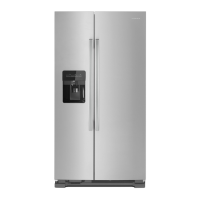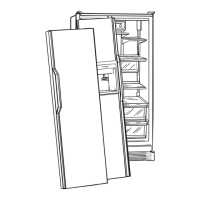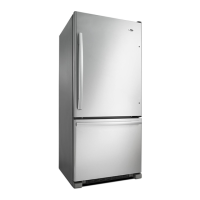April 1998 17 RS5290000 Rev. 0
Symptom Possible Causes Corrective Action
Refrigerator temperature control set
too cold
Adjust refrigerator temperature
control
Refrigerator section too cold
Refrigerator airflow not properly
adjusted
Adjust airflow grille to freezer.
Adjust Beverage chiller and Chiller
Fresh temperature controls.
Temperature controls set too warm Reset temperature controls.
Poor door seal Level cabinet. Adjust hinges.
Replace gasket.
Dirty condenser or obstructed grille Check condenser and grille. Clean.
Faulty control Test control. Replace if defective.
Defrost heater remains open Check evaporator.
Freezer and refrigerator sections too
warm
Refrigerant shortage or restriction Check for leak or restriction. Repair,
evacuate and recharge system.
Freezer temp control set too cold Adjust freezer temperature controlFreezer section too cold
Faulty control Test control. Replace if defective.
Temperature control set too cold Adjust temperature control.
Dirty condenser or obstructed grille Check condenser and grille. Clean.
Poor door seal Level cabinet. Adjust hinges.
Replace gasket.
Interior light remains on Check switch. Check door activates
switch. Adjust or replace if switch.
Faulty condenser fanor evaporator
fan
Check fan switch, fan, and wiring.
Replace if necessary
Faulty control Test control. Replace if defective.
Refrigerant shortage or restriction Check for leak or restriction. Repair,
evacuate and recharge system.
Refrigerant overcharge Check for overcharge. Evacuate and
recharge system
Unit runs continuously
Air in system Check for low side leak. Repair,
evacuate and recharge system.
Unit runs continuously. Temperature
normal or warm.
Ice on evaporator See “Ice on evaporator.”
Unit runs continuously. Temperature
too cold or too warm.
Faulty defrost thermostat Check thermostat. Replace if
necessary.
Loose flooring or floor not firm Repair floor or brace floor.
Cabinet not level Level cabinet.
Tubing in contact with cabinet, other
tubing, or other metal
Adjust tubing.
Drain pan vibrating Adjust drain pan.
Fan hitting another part Ensure fan properly aligned and all
attaching hardware and brackets are
tight and not worn. Tighten or
replace.
Worn fan motor bearings Check motor for loss of lubricant or
worn bearings. Replace if necessary.
Compressor mounting grommets
worn or missing. Mounting hardware
loose or missing.
Tighten hardware. Replace
grommets if necessary.
Noisy operation
Free or loose parts causing or
allowing noise during operation
Inspect unit for parts that may have
worked free or loose or missing
screws. Repair as required.
Troubleshooting Chart
To avoid risk of electrical shock, personal injury, or death, disconnect electrical power source to unit and discharge
capacitor through a 10,000 ohm resistor before attempting to service, unless test procedures require power to be
connected. Ensure all earthing wires are connected before certifying unit as repaired and/or operational.
WARNING

